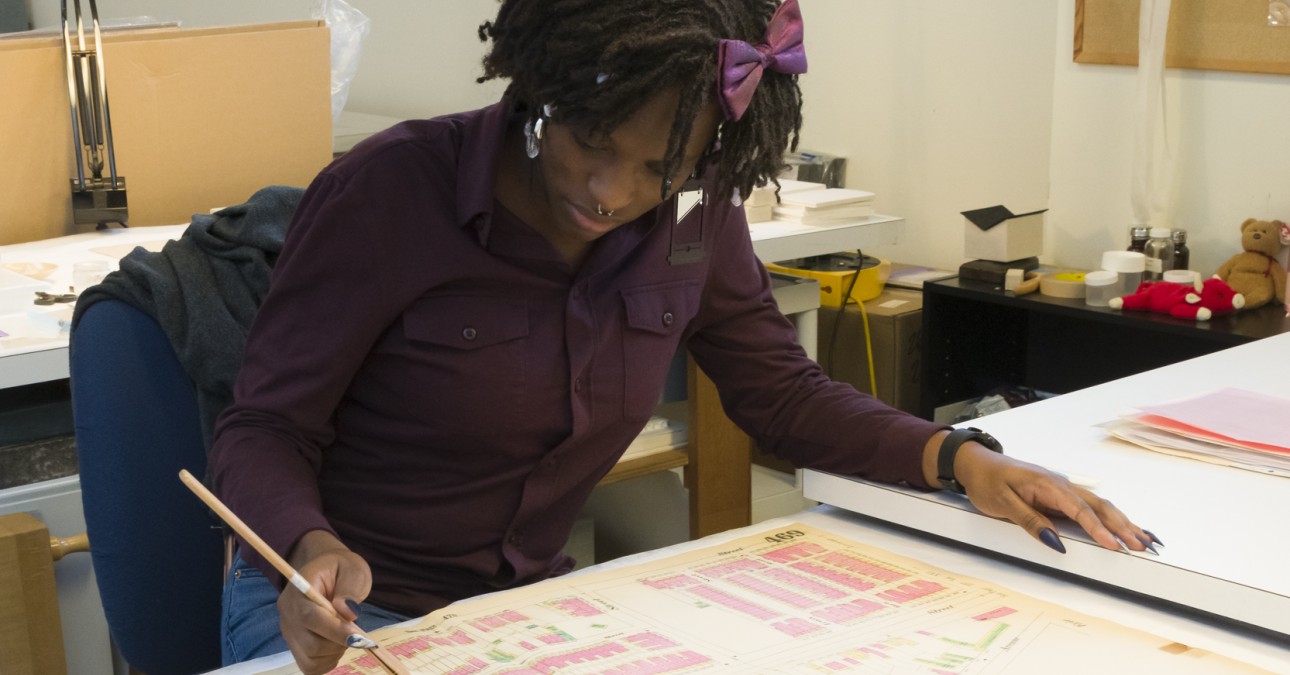
CCAHA Education Programs Train Emerging Professionals
As the calendar enters the autumn months and the sun starts to set earlier, it is also a time of transition at the Conservation Center, where we bid farewell to both our summer interns and our yearlong fellow. This time gives us a moment to pause and think about our role in shaping the next generation of conservation and preservation professionals.
Education is a large part of CCAHA’s overall mission, and every year we are honored to host interns and fellows from across the country and the world who bring a thirst for knowledge and experience. But the relationship is not one-sided — CCAHA benefits from a constant infusion of fresh perspectives.
“Conservation is a field that advances through collaboration and curiosity,” said Executive Director Michelle Eisenberg. “We value the opportunity to welcome fellows and interns not only as a way of passing on skills and knowledge that are best taught through hands-on learning, but also as a way for our staff to continually refresh our techniques.”
"Ideas that fellows bring into the lab from their previous experiences may be just the fresh perspective we need to solve a problem,” said Senior Paper Conservator Heather Hendry. “But additionally, the act of teaching forces you to really interrogate your own understanding of the concept, so I feel that supervising fellows has deepened my knowledge in both directions."
Since CCAHA’s inception in 1977, we have hosted more than 70 postgraduate fellows who spend a year or more working in the lab, gaining hands-on experience in treating and evaluating objects, meeting clients, and writing condition reports — all invaluable training students may not receive in the classroom. In that time, CCAHA has also hosted dozens of conservation interns for shorter periods, as well as preservation internships under the supervision of our Preservation Services Office.
We’ve received generous funding over the years to support our fellowship program from the National Endowment for the Arts, the National Endowment for the Humanities, the Andrew W. Mellon Foundation, the Foundation for Advancement in Conservation, and the Samuel H. Kress Foundation, because our funders know how vital this training is to the future of the profession and our shared cultural and artistic history.
This month we say goodbye to our NEA Book Conservation Fellow Nylah Byrd, who worked for the past year under the supervision of Senior Book Conservator Richard Homer. Nylah graduated from the Winterthur/University of Delaware Program in Art Conservation (WUDPAC) in 2022. She completed her undergraduate education at Stanford University, receiving a B.A. in Archaeology with minors in Chemistry and Studio Art.
Nylah said she was attracted to the fellowship at CCAHA because of the variety of preservation and conservation services offered.
“I wanted more book treatment experience in general,” she said. “In addition to that, with CCAHA being a regional center and having their Preservation Services side, I really just wanted to dip my toes into everything.”
Nylah boasts a particular conservation ethos that CCAHA staff find very interesting. She worked with an unusual combination of artifacts and archives at WUDPAC and aims to work in a cross-disciplinary way, both within the field of conservation and by reaching out to communities that are not always connected to conservation.
During the fellowship year, all fellows embark on an in-depth research project to put their training and new-found knowledge to work. Nylah centered her research project on the George Floyd Global Memorial (GFGM) in Minneapolis, where she spent five days during the Rise and Remember Celebration.
Nylah focused on mold remediation in a community setting. She worked with GFGM to identify objects demonstrating active mold. She then set up a mold remediation room and got to work, treating and stabilizing more than 100 objects. Nylah also helped with photo documentation and participated in a panel on Storytelling and Cultural Heritage.
Nylah said her research project was her favorite part of her fellowship year because of the independent nature of the project.
“I feel like I’m transitioning from someone who more often receives instruction to someone who wants to start a project and see that through to the end,” she said.
And, she said her time at CCAHA has really helped her improve her presentation skills.
“Something I’ve been working on is making things accessible to different audiences,” she said. “It’s easy to get bogged down in conservation terminology, which not everybody understands. I’ve learned how to explain things more concisely and clearly to the general public.”
Looking ahead, Nylah plans to collaborate with GFGM and the Midwest Art Conservation Center to create a mold remediation quick reference guide for community conservation projects. She will also submit a poster about her research project to the American Institute for Conservation’s annual meeting.
She offered a nugget of advice for other emerging conservation professionals who might feel shy sharing information.
“You have to advocate for yourself,” she said, “because sometimes someone might not think of something unless you say it. Speak up more often than you think you have to.”